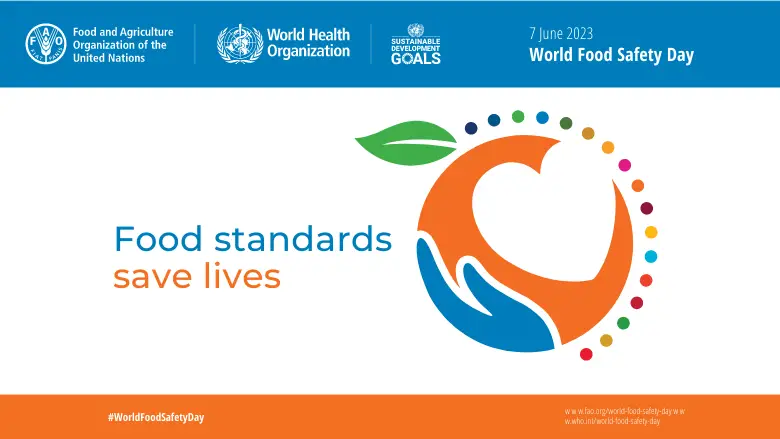Today, 7 June 2023, is World Food Safety Day, a day the World Health Organisation has set aside to focus on failings in food safety and to celebrate achievements in food safety. This year’s theme is about how food standards in food safety save lives. There’s no doubt that they do. When one looks back to the 19th century, even, or maybe especially, in the the great industrialised nations of the modern world, up and coming food manufacturers, either out of ignorance or deliberately, manufactured foods that were certainly not in the public’s best interests. While we don’t have the level of morbidity and mortality we once did, there’s no doubt that foodborne disease represents a totally unacceptable high amount of illness, death and economic burden in our communities. What makes it even more difficult to understand is that foodborne illness is largely preventable, through the following of procedures, processes and protocols that have been developed following rigorous basic scientific research. Thus, food standards at all levels (local, state, federal), play an absolutely critical role in safeguarding the food supply of a nation.
In this article, we want to focus on the Food Safety Modernization Act (FSMA), a turning point in food safety in the United States that came into being only 12 years ago.
Introduction
FSMA, enacted in 2011, is a landmark legislation that revolutionized food safety practices in the United States. Designed to address the challenges posed by an increasingly complex and global food supply chain, the FSMA introduced a comprehensive framework to prevent foodborne illnesses and ensure the safety of the nation’s food supply. This article examines the key provisions of the FSMA, its impact on the food industry, and the strides made in safeguarding public health through enhanced preventive measures and regulatory oversight.
Overview of the FSMA
The FSMA shifted the focus of food safety in the USA from reactive measures to a proactive, preventive approach. It empowered the Food and Drug Administration (FDA) with the authority to set stringent standards and regulations across the entire food supply chain, from farm to fork. The act encompasses several key components, including preventative controls, inspections, import safety, response to outbreaks, and enhanced partnerships.
Preventive controls
One of the cornerstones of the FSMA is the establishment of preventive controls to identify and address potential hazards before they can cause harm. This includes the implementation of Hazard Analysis and Risk-Based Preventive Controls (HARPC) by food facilities. HARPC mandates a systematic approach to evaluate and prevent biological, chemical, and physical hazards in food production, processing, and distribution. It requires food manufacturers to develop and implement comprehensive food safety plans, conduct regular risk assessments, and institute preventive measures.
Inspections and compliance
The FSMA introduced a risk-based inspection strategy to ensure compliance with food safety standards. It provided the FDA with increased authority to conduct inspections, sampling, and testing of food facilities. The act also mandated the establishment of a third-party certification program, enabling accredited auditors to assess and certify compliance with the FSMA requirements. Non-compliant facilities can be subject to corrective actions, penalties, and even product recalls if necessary.
Import safety
Recognizing the importance of imported foods in the American market, the FSMA strengthened the FDA’s oversight of imported food products. It mandated the development of a Foreign Supplier Verification Program (FSVP), which places responsibility on importers to verify that their foreign suppliers meet U.S. safety standards. The act also granted the FDA authority to refuse entry to imported goods from non-compliant facilities and increased the frequency of inspections for high-risk products.
Outbreak response and partnerships
In the event of a foodborne illness outbreak, the FSMA equipped the FDA with enhanced tools to respond swiftly and effectively. It established a food tracing system to track and trace products throughout the supply chain, enabling rapid identification of the source of contamination. Furthermore, the FSMA emphasized collaboration between federal, state, and local agencies, as well as industry stakeholders, to share information and resources and foster a culture of proactive food safety practices.
Impact and challenges
The FSMA has had a profound impact on the food industry, leading to improved food safety practices and reduced foodborne illnesses. By shifting the focus towards prevention, the act has encouraged proactive measures, such as better recordkeeping, increased training, and improved sanitation practices. However, implementing the FSMA’s requirements posed challenges for smaller farms and food facilities due to resource constraints and compliance costs. To address these concerns, the FDA has provided educational resources, technical assistance, and flexibility in certain compliance deadlines.
Conclusion
The Food Safety Modernization Act has transformed the landscape of food safety in the USA. By prioritizing prevention, enhancing regulatory oversight, and fostering collaboration, the FSMA has made significant strides in safeguarding public health and strengthening consumer confidence in the nation’s food supply. Continuous

